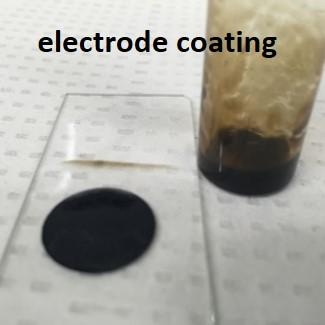New gel-like coating beefs up the performance of lithium-sulfur batteries

An electrode is coated with a layer of the new material. Credit: Yale University
In a study published online March 20 in the Proceedings of the National Academy of Sciences, researchers describe the new material — a dendrimer-graphene oxide composite film — which can be applied to any sulfur cathode. A cathode is the positive terminal on a battery.
According to the researchers, sulfur cathodes coated with the material can be stably discharged and recharged for more than 1,000 cycles, enhancing the battery's efficiency and number of cycles.
“Our approach is general in that it can be integrated with virtually any kind of sulfur electrode to increase cycling stability,” said Hailiang Wang, assistant professor of chemistry at Yale and lead investigator of the study. “The developed film is so thin and light it will not affect the overall size or weight of the battery, and thus it will function without compromising the energy and power density of the device.”
New types of electrodes — positive and negative terminals — are considered essential for the development of a new generation of high energy-density batteries. As lithium-ion batteries begin to reach their capacity limits, many researchers are looking at lithium-sulfur as a solution. Sulfur is both lightweight and abundant, with a high theoretical energy capacity. However, existing lithium-sulfur battery technology suffers from a loss of capacity during cycling.
The Yale team made its discovery by combining the distinct properties of two material components. They merged the mechanical strength of graphene oxide with the ability of a dendrimer molecule to confine lithium polysulfides. The result is a gel-like slurry that can be readily coated as a 100-nanometer-thin film onto sulfur electrodes.
###
The corresponding authors of the study are Gary Brudvig, the Benjamin Silliman Professor and chair of chemistry, professor of molecular biophysics and biochemistry, and director of the Yale Energy Sciences Institute at Yale West Campus; Yale chemistry professor Victor Batista; and Wang.
Co-authors of the study are Wen Liu, Jianbing Jiang, Ke R. Yang, Yingying Mi, Piranavan Kumaravadivel, Yiren Zhong, Qi Fan, Zhe Weng, Zishan Wu, and Judy Cha, all of Yale, and Henghui Zhou of Peking University.
Media Contact
All latest news from the category: Materials Sciences
Materials management deals with the research, development, manufacturing and processing of raw and industrial materials. Key aspects here are biological and medical issues, which play an increasingly important role in this field.
innovations-report offers in-depth articles related to the development and application of materials and the structure and properties of new materials.
Newest articles

A universal framework for spatial biology
SpatialData is a freely accessible tool to unify and integrate data from different omics technologies accounting for spatial information, which can provide holistic insights into health and disease. Biological processes…

How complex biological processes arise
A $20 million grant from the U.S. National Science Foundation (NSF) will support the establishment and operation of the National Synthesis Center for Emergence in the Molecular and Cellular Sciences (NCEMS) at…

Airborne single-photon lidar system achieves high-resolution 3D imaging
Compact, low-power system opens doors for photon-efficient drone and satellite-based environmental monitoring and mapping. Researchers have developed a compact and lightweight single-photon airborne lidar system that can acquire high-resolution 3D…





















